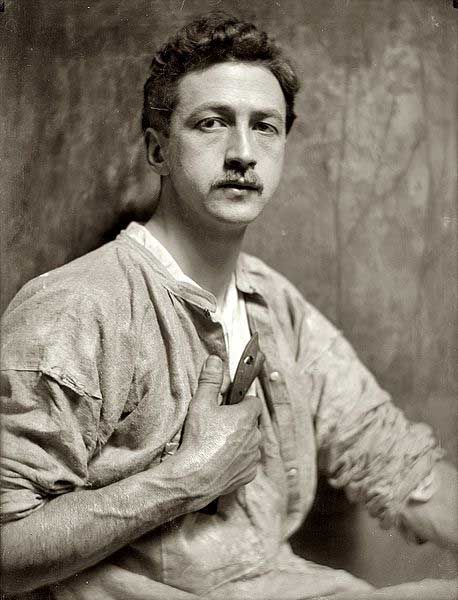Artist Index
A - B - C - D - E - F - G - H - I - J - K - L - M
N - O - P - Q - R - S - T - U - V - W - X - Y - Z
Sculptures

Beyond

The Nymph
Chester A. Beach (1881–1956) was an American sculptor who was known for his busts and medallic art.
Early life
Beach was born in San Francisco, California. He studied initially at the California School of Mechanical Arts and worked as a jewelry designer immediately afterward, while continuing his art studies at the Mark Hopkins Institute of Art. In 1903 he moved to New York City and in May 1904, he moved to Paris to study at the École des Beaux-Arts as well as under the tutelage of Charles Raoul Verlet in the Académie Julian.

Chester Beach , 1910
Career
He returned to the U.S. in 1907 and quickly gained a following for his representations of allegorical and mythical figures.[1] That year, he established his studio in Manhattan, which he maintained for the next forty-five years.[2] He was soon elected to the National Sculpture Society, the Salmagundi Club and the American Numismatic Society. When he was selected to join the National Academy of Design, he was the youngest member at the time.[3] He was also later selected for the National Institute of Arts and Letters.
In 1910, Beach married Eleanor Hollis Murdock, whom he had met while in France. The couple settled in Rome for two years, returning to the U.S. in 1912 with their first daughter Beata (later a painter married to Vernon Porter). Daughters Eleanor and Natalie were born in America. His first major commission came in 1915, when he designed three statues for the Panama-Pacific International Exposition, for which he received a Silver Medal. His 1919 submission for a medal commemorating the Treaty of Versailles was selected as the winner by the American Numismatic Society.[4] His best-known busts are found in the New York University Hall of Fame.[1]
A prolific worker, Beach exhibited works yearly without fail at the National Academy of Design winter and annual exhibitions from 1907–26. He was president of the National Sculpture Society from 1926–27 and also taught at the Beaux-Arts Institute of Design and the Grand Central School of Art. He received the Numismatic Society's Saltus Medal in 1946 for his medallic work.
In 1917 Beach built a studio in Brewster, New York on 10 acres (40,000 m2) of land he acquired in trade from a local farmer for two sculptures. A year later he built a home for his family of stone from the old stone walls on the property. This became known as "Old Walls". He built an additional cottage on the property in 1947 known as "The Camp".
Beach died on August 6, 1956 in Brewster, New York.
References
1. ^ a b Dearinger, David Bernard (2004). Paintings and Sculpture in the Collection of the National Academy of Design. Hudson Hills. pp. 29–30. ISBN 1555950299. http://books.google.com/books?id=PHH45aYubp4C&pg=PA29&lpg=PA29&dq=%22chester+beach%22&source=web&ots=yahoKeLNjt&sig=FrwmcTqyWNLZT4RWW6vS3mgIBrc&hl=en&sa=X&oi=book_result&resnum=1&ct=result#PPA29,M1.
2. ^ "Chester Beach, a Sculptor, 75". The New York Times. August 8, 1956.
3. ^ "ACTORS' MEDAL FOR TAFT". The New York Times. January 18, 1910. http://query.nytimes.com/gst/abstract.html?res=9400E0DC1139E333A2575BC1A9679C946196D6CF.
4. ^ "WINS PEACE MEDAL PRIZE.; Chester Beach's Design Is Accepted by Numismatic Society." (PDF). The New York Times. June 30, 1919. http://query.nytimes.com/gst/abstract.html?res=9D0CE3DB143AE03ABC4850DFB0668382609EDE. Retrieved 2008-11-19.
From Wikipedia. Text is available under the Creative Commons Attribution-ShareAlike License
